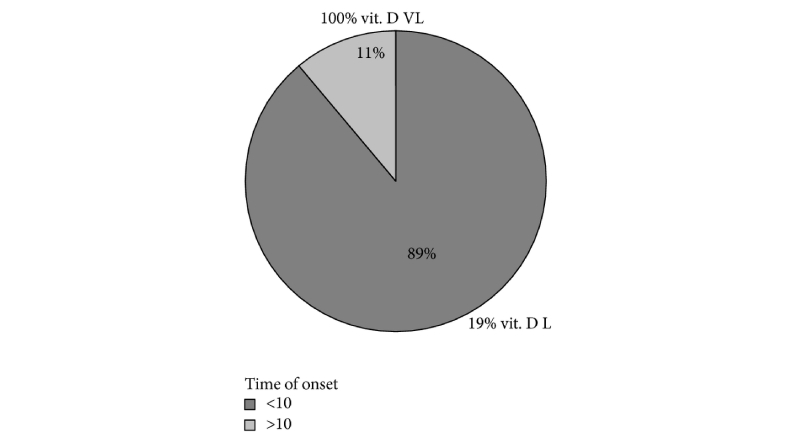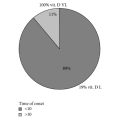Background
In today’s fast-paced society, it’s not uncommon for people to put their health last on the list of priorities. Because of this, lifestyle diseases like vitamin deficiencies are on the rise, possibly due to inadequate nutrition and lack of sunlight because of long hours spent indoors. Insufficiencies in these areas have been linked to a wide range of potential difficulties.
Objective
Aiming to predict vitamin B12 and vitamin D3 concentrations in the blood of vegetarian workers.
Components and Techniques
Participants who met the inclusion criteria and provided written consent filled out a questionnaire about their eating and exercise habits. Symptoms of vitamin B12 and vitamin D3 deficiency, as well as questions about smoking and alcohol use histories, drug and supplement use, and socioeconomic status, were also collected from participants. Measurements of serum B12 and D3 concentrations were made from the collected blood samples.
Results
Among the participants, 14.00% were found to be vitamin B12 deficient, while 82.00% were found to be D3 deficient. Deficiencies in vitamin B12 were found in 10% of women and 14% of men, and in vitamin D3, 100% of women and 80% of men, respectively; these differences did not reach statistical significance. For example, 15.49% of those between the ages of 35 and 45 were B12 deficient, while 91.55% of those between the ages of 46 and 55 were D3 deficient. Of the four participants older than 55, none were B12 deficient, but 25% were D3 deficient (p=0.00002). Participants who said they never exercised were nearly unanimously deficient in vitamin D3 (96.15%) compared to those who did exercise (77.02%; OR=0.13, p=0.043). Alcohol consumption was not associated with vitamin B12 (p=1) or D3 (p=0.713) deficiencies.
Conclusions
Results showed that vegetarians working in corporations were more likely to be deficient in both vitamin B12 and vitamin D3. Vitamin sufficiency might be enhanced through education, dietary changes, deliberate exercise, and, most importantly, care for one’s health. There is a higher risk of vitamin D3 deficiency in women over the age of 45, so they need to take special care. To fully grasp vitamin deficiencies and devise effective preventative measures, more research is needed to evaluate nutrition profiles among other populations.
Introduction

Many workers in today’s economy spend many hours each week inside. Reduced energy and stamina are just two of the negative health effects that workers may experience due to their lack of exposure to sunlight during office hours [1]. Proper functioning and metabolism rely on a diet rich in vitamins and other micronutrients [1]. Few studies have looked at vitamin deficiencies in specific groups, such as vegetarians [2,3]. This study set out to determine the vitamin B12 and D3 serum levels of vegetarian workers in India in an effort to raise awareness and supply crucial information to policymakers and human resource management teams.
Water-soluble vitamins are those that can be dissolved in water, and fat-soluble vitamins, like vitamin D, are those that can be stored in the body (e.g., vitamin B12). Although some vitamins can be absorbed through the skin, the majority of vitamin intake occurs through food. For instance, the skin can produce vitamin D3 (also known as cholecalciferol) when exposed to sunlight [4]. Normal bone mineralization, growth, and remodelling, as well as the prevention of hypocalcemic tetany, rickets, and osteomalacia, are all dependent on vitamin D’s ability to increase intestinal calcium absorption [5-7]. Both children and adults may experience muscle pain due to a lack of vitamin D [8-10]. Low levels of vitamin D in the blood were linked to more severe hair loss in a study of people with alopecia areata [11]. A lack of vitamin D can make it harder to fight off infections [14,15] because of its role in regulating cell growth, neuromuscular and immune functions, and inflammation. Vitamin D deficiency has been linked to chronic lower back pain [16-18], as well as depression [19,20], according to large observational studies. Vitamin D, in conjunction with calcium, is useful in preventing osteoporosis in the elderly. Since older adults typically spend more time indoors and have less capacity to synthesise vitamin D, they are more likely to develop a deficiency [6]. Vitamin D3 deficiency has been shown to be on the rise globally, even in tropical climates with abundant sunlight, such as urban India [21,22]. Other risk factors for deficiency include working indoors and wearing protective clothing (such as long robes and head coverings, such as for religious reasons) [21,23].
Also Read :An Evergreen Health Tip Is To Keep Your Teeth In Good Condition
Myelination, DNA synthesis, healthy red blood cell formation, and hemopoiesis are all processes that rely on vitamin B12 [4,24-26]. Lack of vitamin B12 has become more common. Vitamin deficiency manifests itself in a wide variety of ways, including lethargy, exhaustion, dizziness, heart palpitations, shortness of breath, constipation, tingling, and numbness. Executives, particularly vegetarians and the elderly, are at high risk for vitamin B12 deficiency, according to a study conducted in Mumbai [2].
Substances & Techniques
The institutional ethics sub-committee (reference number I.E.S.C./40/2020) at Dr. D. Y. Patil Medical College, Hospital, and Research Centre in Pimpri, Pune, India, gave their blessing to this cross-sectional study. Participants were selected using a Google form survey that inquired about their full names, ages, sexes, occupations, and dietary preferences (vegetarian or non-vegetarian). Both men and women who work in the corporate sector and who consider themselves vegetarians were considered for this study. Participants who did not provide informed consent, who did not report being vegetarian, who did not report taking vitamin supplements, and who were chronically and severely ill were not included. After thoroughly explaining the procedure, written consent was obtained from all participants. The prevalence of Vitamin B12 was 48.4% [27] and Vitamin D was 67.9% [28] among people who were randomly sampled. The minimum sample size needed to detect a true prevalence of 48.4% was calculated to be 96, given a 95% confidence limit and an absolute error of 10%. We did, however, recruit a total of 100 people for the study. WinPepi version 11.65 was used (Brixton Health, London, UK).
Each person filled out a lengthy survey about their lifestyle habits, including what they ate and how often they exercised, as well as questions about any medications or supplements they took, any alcohol or drug use they may have had in the past, any vitamin deficiencies they may be experiencing, and their demographics. Serum B12 and D3 levels were measured using a Roche kit [29]. A vitamin D3 (B12) deficiency was defined as a level below the reference range, while a vitamin D3 (B12) level above the reference range was considered adequate. Vitamin D insufficiency was defined as a serum level between 20 and 30 ng/mL, while vitamin D deficiency was defined as a level below 20 ng/mL. Deficiency was considered to be below 200 pg/ml, marginal deficiency between 200 and 300 pg/ml, and normal above 300 pg/ml [30].
Information was analysed with the help of Microsoft Excel (Microsoft Corporation; Redmond, WA) and Epi Info (CDC, Atlanta, GA). Means and percentages are used to describe the data. Chi-square tests for categorical data and t-tests were used to determine statistical significance.










Leave a Reply